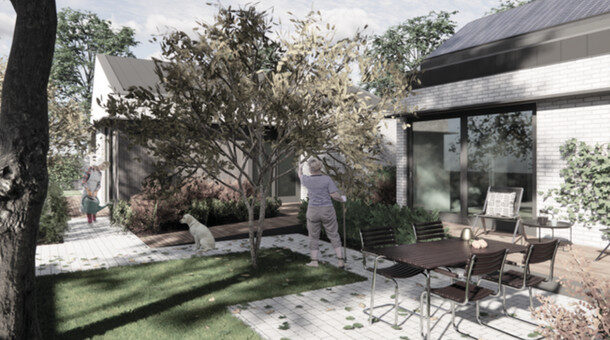At the Australian Institute of Architects’ recent national conference, a moment of genuine optimism swept the room during a panel discussion on housing. When Dr Damian Madigan announced that the Future Living Code Amendment had officially been adopted by the South Australian Government, it was met with an enthusiastic ovation — and for good reason.
This significant planning reform paves the way for co-living housing models in established suburbs, enabling a fresh, flexible approach to home ownership and affordability without compromising the character, green space, or social fabric of our communities.
While it’s not a silver bullet to the housing crisis, the Future Living model is a robust, research-driven solution that adds a much-needed layer of choice to a market desperately in need of it.
Backed by a Decade of Research
Led by architect and academic Dr Damian Madigan, the proposal has been developed over more than 10 years through extensive research, analysis, and real-world modelling. It focuses on character suburbs — typically those with older homes on large blocks — where there is resistance to more disruptive forms of infill development. Rather than demolishing a house and replacing it with two or more dwellings that often diminish urban tree canopy and increase hard surface areas, the Future Living model encourages retention and adaptation. It allows for a character home to be repurposed into a co-living property accommodating up to three self-contained homes, each with private space and shared communal garden areas. Learn more about the Future Living Code Amendment and access supporting documentation via View code amendment | PlanSATackling Common Concerns with Facts
Concerns raised by some in the community — such as increased traffic, pressure on services, and loss of green space — are often driven by a fear of the unknown rather than an understanding of the specifics. The proposal does not allow for increased site density in terms of number of people per land area. Instead, it supports diversifying household structures within the same built footprint. For example:- A traditional family home occupied by four people and three cars may now house three smaller households (e.g. two couples and one single), with no increase in cars or service use — and potentially a lower environmental impact.
- A family might convert their property so an adult child can live independently but affordably on-site, or allow an elderly parent to downsize and age in place with dignity and support.
A Balanced, Community-Minded Approach
The Amendment isn’t just about housing — it’s about living well, together. It includes safeguards and guidelines to support community cohesion and environmental integrity:- Shared green space is required, allowing room for trees and social interaction.
- Private outdoor areas ensure each household maintains autonomy.
- A formal management agreement is mandated to establish clear rules about shared areas, pets, noise, and maintenance — helping prevent future disputes.
Visionary Planning in Action
This Code Amendment is a timely, forward-thinking response to an urgent issue, and those who brought it to life — from Dr Damian Madigan to the SA Planning Commission and participating councils — deserve credit for their leadership and commitment to innovation. We urge all members and stakeholders to explore the detail of this planning reform, engage in community conversations, and consider how these changes might apply in their own practice, neighbourhoods, and advocacy efforts.“Change often comes with discomfort, but when it is grounded in research, community benefit, and practical application, it becomes an opportunity to do better — for more people, for longer.”
Nicolette Di Lernia, Executive Director, Australian Institute of Architects

